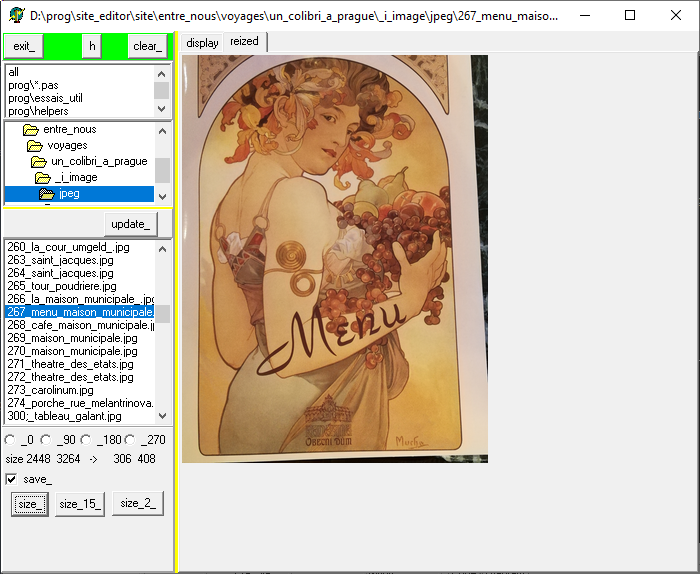|
Delphi Image Resizing - Felix John COLIBRI. |
- abstract : resizing JPG images using the Graphics32 library. Load the JPEG, possibly rotate it, scale it, save it as a .PNG
- key words : .JPG, .JPEG, .PNG, image resizing, image rotation, .JPEG to
.PNG conversion, Graphics32, tKernelResampler, tImage32, tBitmap32
- hardware used : intel i3-8100, 3.6 gHz, 8GB memory, 128 G and 1 T hard disc
- software used : Windows 10 64 bit, Delphi 7
- scope : Delphi 1 to 7, 2006 to 2010, Xe, Seattle, Tokyo, Berlin, 10.3
- level : Delphi developer
- plan :
1 - Resizing Jpeg Images Writing a small .HTML report about a vacation trip, I wanted to resize the .JPG files. We used 3 different devices (a Panasonic camera, a Huawei Smartphone, an
iPhone6), and the image sizes were too big and of different sizes. Using Delphi tBitMap.StretchDraw is quite easy, but the result is poor. So, looking at StackOverflow, the best solutions presented was to use Graphics32 library.
This article simply presents an application which uses this library to resize images
2 - Delphi Image Resizing App 2.1 - Graphics32 image library
We downloaded both the basic Graphics32 library and the PNG library (since for our web pages, all images are .PNG files)
2.2 - The Delphi Application The Delphi project simply imports both Graphics32 directories using the
SearchPathes options (no need to add components to the palette) The overall project structure is the usual tDirectoryListBox / tFileListBox combination. Clicking on a .JPG file in the tFileListBox
2.3 - Mini HowTo Here is the snapshot of the project  and
- create a directory for the resulting resized .PNG
- create a sub-directory and place all your .JPG in this directory
- start delphi_resize_images.exe
- in the DirectoryListBox1, select the .JPG directory
- for as many images as you like
- select a .JPG in the FileListBox1
- if the image is not upright, rotate it by clicking _90, _180 or _190
- click one of the resizing button: size_ for the computed sizes,
size_15_ for 1.5 size and size_2_ for double target size
- if the result is satisfactory, check save_, click one of the size_ buttons, and
- the result will be saved in the parent directory
- the file name will bs stored in the ClipBoard (for inserting in the .HTML <IMG tag)
3 - Comments and links 3.1 - Comments
- we only computed the resizing based on a hard coded 500 pixel width. This could be placed in an Edit, and the computations could take the Width or Height, depending on the portrait or landscape display of the image
- the 500 pixel value is a self imposed limit: we want to avoid scrolling of the .HTML page, and for 778 width screen pages, this is a reasonable figure.
- I basically assumed that dividing the image size by powers of 2 would result
in better compression (less artifacts), but did not check. If the Graphics 32 algorithm is not sensible to this factor, we could avoid the power of 2 computations and resize exactly to fit the target size (500 pixel width in our case)
- the procedures should also be parameterized instead of using globals
- there still remains an update problem (which we also had with our StretchDraw program): when size_ is clicked, the image is not always
displayed. Selecting the display_ tabsheet and the resized_ tabs again forces a refresh and solves the problem, in a somehow unsatisfactory way
3.2 - Links
4 - Download the Sources Here are the source code files: You MUST download the Graphics32 libraries (link above) and replace the SearchPathes accordingly
The .ZIP file(s) contain: - the main program (.DPR, .DOF, .RES), the main form (.PAS, .DFM), and any other auxiliary form
- any .TXT for parameters, samples, test data
- all units (.PAS) for units
Those .ZIP
- are self-contained: you will not need any other product (unless expressly mentioned).
- for Delphi 6 projects, can be used from any folder (the pathes are RELATIVE)
- will not modify your PC in any way beyond the path where you placed the .ZIP (no registry changes, no path creation etc).
To use the .ZIP: - create or select any folder of your choice
- unzip the downloaded file
- using Delphi, compile and execute
To remove the .ZIP simply delete the folder. The Pascal code uses the Alsacian notation, which prefixes identifier by
program area: K_onstant, T_ype, G_lobal, L_ocal, P_arametre, F_unction, C_lass etc. This notation is presented in the Alsacian Notation paper.
As usual:
- please tell us at fcolibri@felix-colibri.com if you found some errors, mistakes, bugs, broken links or had some problem downloading the file. Resulting corrections will
be helpful for other readers
- we welcome any comment, criticism, enhancement, other sources or reference suggestion. Just send an e-mail to fcolibri@felix-colibri.com.
- or more simply, enter your (anonymous or with your e-mail if you want an answer) comments below and clic the "send" button
- and if you liked this article, talk about this site to your fellow developpers, add a link to your links page ou mention our articles in your blog or newsgroup posts when relevant. That's the way we operate:
the more traffic and Google references we get, the more articles we will write.
5 - The author Felix John COLIBRI works at the Pascal
Institute. Starting with Pascal in 1979, he then became involved with Object Oriented Programming, Delphi, Sql, Tcp/Ip, Html, UML. Currently, he is mainly
active in the area of custom software development (new projects, maintenance, audits, BDE migration, Delphi
Xe_n migrations, refactoring), Delphi Consulting and Delph
training. His web site features tutorials, technical papers about programming with full downloadable source code, and the description and calendar of forthcoming Delphi, FireBird, Tcp/IP, Web Services, OOP / UML, Design Patterns, Unit Testing training sessions.
|